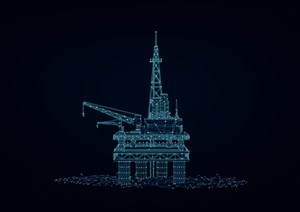Powering digital transformation in the oil and gas industry with robust network solutions
The oil and gas industry is no stranger to technological advancements, and as business becomes increasingly digital, this sector is also embracing digital transformation to improve operations, reduce costs and enhance safety. A robust, hybrid network solution is at the heart of this transformation, enabling companies to unlock the full potential of applications and processes.
In the offshore energy sector, access to reliable real-time data is crucial for decision-making. With a secure, highly integrated network in place, operators in the vessel and rig markets can collect, transmit, and analyze data from multiple sensors and equipment in real-time. This data includes information from seismic survey, drilling operations, production processes and safety monitoring systems, enabling operators to respond swiftly to changing conditions and optimize their operations.
The industry operates in remote and challenging environments, making it difficult for personnel to be physically present at all times. Using a hybrid network solution, operators can remotely monitor and control critical equipment and processes. This capability is particularly valuable for offshore drilling rigs and remote oil fields. It allows operators to make adjustments and troubleshoot issues without the need for frequent site visits, reducing operational costs and increasing safety.
Safety remains the top priority in the oil and gas industry, since accidents can have catastrophic environmental and human consequences. Connecting assets and critical components enables the implementation of advanced safety systems, including real-time monitoring of personnel, equipment, and environmental conditions. These include wearable devices equipped with sensors to transmit vital health and safety information to a central hub, allowing immediate response in case of emergencies. Hybrid network connectivity also supports the deployment of remote assets for safety inspections and emergency response, reducing risks to personnel.
Moving from periodic to predictive maintenance is a game-changer for the energy sector. With a reliable network connection, operators can collect data from sensors and equipment to predict when maintenance is needed. This approach can reduce downtime and maintenance costs and increases productivity of assets. For example, monitoring the condition of the hardest working parts using the Internet of Things can alert operators to potential issues before they lead to costly failures.
The use of digital twins which replicate physical assets in the virtual world have immense potential in the energy industry. These digital replicas can be used for simulations, performance optimization and predictive analytics, enabling operators simulate different operating scenarios and assess the impact of changes in real-time.
The energy transition away from fossil fuels and towards renewable alternatives presents a challenge to conventional energy production to increase efficiency and it also provides business opportunities. The expansion of the offshore wind sector could see generating capacity grow eightfold by 2030. Each windfarm development requires dedicated vessel assets during construction and subsequent maintenance as well as the collection of operational data on a real time basis, creating a new demand for real time network solutions.
The energy sector is a ‘project-by-project’ business and although there are similarities, each one has its own challenges and requirements. These sites are run by multiple stakeholders, with differing requirements, all of whom require precision and efficiency at the core of their operation. Each stakeholder is demanding in their own way and all must be provided with services that allow them to take advantage of the most advanced digital tools and services, whether for production, asset management or operations.
Multi-million-dollar energy assets, as well as the vessels and contractors that support them, require robust and reliable access to data and information to drive operations and business decisions. This calls for a partner that can provide digital solutions that combine a hybrid network with guaranteed uptime and performance, with integration to digital services including network optimization techniques like software-defined networks and cyber protection.
Marlink’s provision of tailored digital solutions enables customers in the energy sector to manage complex and critical operations with the flexibility and scalability required. This enables multiple stakeholders to utilize different bandwidth at different times, while always having the ability to access applications they require. Marlink is able to deliver this required user experience based on an intimate understanding of the business and customer needs.
A robust, reliable hybrid network solution is the backbone of digital transformation in the oil and gas industry. Improving connectivity between floating assets and shore enables real-time data analysis, remote monitoring and control, enhanced safety measures and predictive maintenance and opens the way for future technologies such as simulation, digital twins and the use of AI.
Leveraging these capabilities, operators can streamline their operations, reduce costs and adapt to changing industry dynamics while ensuring safety. As the oil and gas industry faces challenges on macro and micro-economic levels including the transition to sustainable energy sources, the use of data and insights driven by digital network solutions will be an essential tool for remaining competitive and meeting the complex demands of the future.




